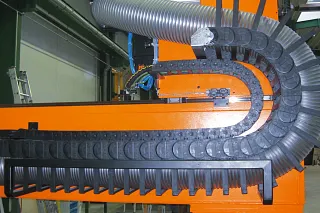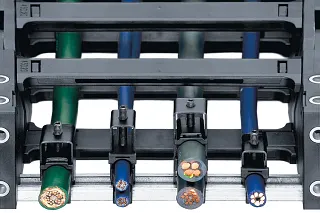Change Language :
Optimal Cable and Hose Management with igus Energy Chains
General rules for cables and hoses in energy chains

The primary benefit of our energy chain systems lies in their ability to securely house numerous types of data cables and power sources together. We offer guidance on segregating different media types, such as keeping bus and motor cables at a safe distance from each other. It’s possible to combine pneumatics, electrical cables, and hydraulics within the same compartment. Beyond cable quality, the placement and allotted space for each cable within the energy chain are crucial for its longevity. With a range of separation options, our energy chains can be customized to meet the unique needs of every application, and this section outlines comprehensive recommendations for doing so.
Contents
Maximum cable or hose diameter
To ensure optimal performance, select cable and hose diameters that correspond to the inner height of the energy chains and tubes, factoring in the necessary clearance. This clearance should be a minimum of 10% for electrical round cables and 20% for hydraulic hoses. An ideal configuration within an energy chain accounts for adequate lateral clearance between adjacent cables or hoses. The clearance may vary based on the operational dynamics and the desired longevity of the system. For specialized applications requiring alternative clearances, please contact our experts.
Electrical cables require at least 10% clearance space all around, and hydraulic hoses require 20%.
The maximum cable/hose diameter is specified for each energy chain series on the relevant product page and in the relevant catalogue chapter.
Instructions for energy chain interior separation

To maintain system integrity, it is essential to segregate cables and hoses of significantly varying diameters using separators. It is critical to prevent entanglement; hence, the clearance height within a compartment housing multiple similar cables or hoses should not exceed 1.5 times of the diameter of the largest cable or hose. Additionally, the weight distribution of cables or hoses should be balanced across the energy chain’s width. To avoid adhesion, cables and hoses with dissimilar outer jacket materials should be positioned independently.
Filing rules
The cables and hoses must be laid so that they can move freely at all times and so that no tensile force is exerted on the energy chain at the radius. For high-speed applications and high numbers of load cycles, cables or hoses must not be laid on top of each other without horizontal separation. The standard values for this are: travel speed over 0.5m/s and load cycles over 10,000 p.a. igus interior separation offers a safe solution for such cases.
Bend radius R

Your energy chain's bend radius depends on the thickest or stiffest cable or hose in your filling. The bend radii should be adjusted to the recommendations of the cable or hose manufacturer. Selecting a larger radius than the minimum will extend service life. The specification of minimum bend radii for cables and hoses refers to normal temperatures. Other bend radii may be recommended.
Filling rules | Round electrical cables
For electrical cables, the round cable is a safe, modular, cost-effective solution for energy chain systems.

Installation and strain relief for round electrical cables
1) The cables must be laid straight, without twisting. Cables must not be uncoiled from the top of the spool. Our chainflex cables are immediately ready for placement directly into the e-chain®. They need not be disconnected or laid out before installation.
2) The cables must be laid in such a way that each individual cable can move freely in the longitudinal direction.
3) The cables must be able to move freely along the radius. This must be double-checked if the upper run has reached the greatest free length
4) igus interior separators are necessary if several cables and/or hoses with varying diameters are inserted. It is important to prevent cables and hoses from tangling.
5) Cables and hoses with different jacket materials must not be allowed to stick together. They may need to be separated. igus chainflex cables of all series can be combined.
6) Round electrical cables must have strain relief at both ends. In exceptional cases, cables may have strain relief at the energy chain's moving end only. A gap of 10-30 times the cable diameter between the end of the bend segment and the fixed point is recommended for most cables. chainflex cables can, on the other hand, have strain relief directly at the mounting bracket, as testing has confirmed.
Filling rules | Pneumatic hoses
Filling rules | Flat cables
Filling rules | Hydraulic hoses
Strain relief

Hydraulic hoses are most often stretched lengthwise during operation. This must be taken into account when strain relief is applied. More hose length can be factored in or strain relief implemented. In some cases, one-sided strain relief on the moving end can be tolerated.
rollclip

In almost all cases, the broad, smooth, rounded contact surfaces of all igus energy chains/energy tubes are sufficient to protect hydraulic hoses from abrasion. In extreme cases, the rollclip can be subsequently installed. In the crossbar, the hoses come into contact with a series of plastic cylinders which rotate with them. Extreme cases include particularly soft jacket materials, particularly small bend radii, and highly dynamic loads. Our experience shows that over 95% of all applications can be solved without rollclips.






